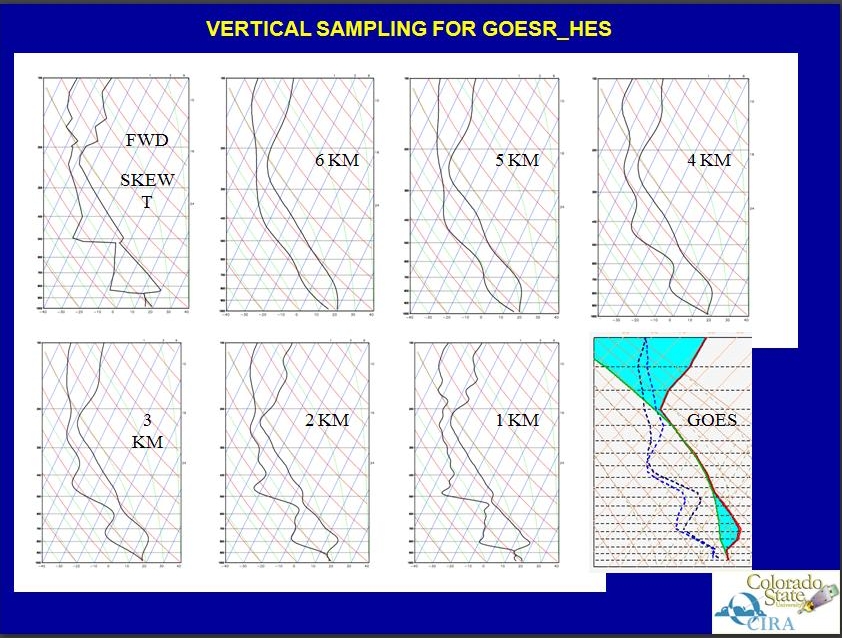What Could Have Been…
(Click for larger view.)
As many of you know (or may not know) the National Oceanic and Atmospheric Administration (NOAA) decided to drop plans for the development of the Hyperspectral Environmental Suite (HES) (aka. the Advanced Baseline Imager/Sounder) for the “next generation” of geostationary weather satellites (GOES-R and Beyond). The common line was that NOAA was not confident that a brand new sensor suite could be developed on time and on budget (for the 2012-2014 launch window for GOES-R).
The HES would have taken much more detailed atmospheric (indirect) measurements of temperature, pressure, humidity, etc.for use by our own NOAA/NWS forecasters with the additional ability of being able to ingest this new data into the NWP computer models and greatly improve the ability to predict severe weather events of all kinds.
The HES’s balance of temporal (30 min). spectral (0.5 cm-1), spatial (2-10 km), and radiometric (0.1 K) capabilities would have replaced the current GOES sounder which has 18 spectral bands. With greater temporal resolution (better than 1 hour), high spatial resolution (better than 10 km), high-spectral-resolution (better than single wavenumber – giving a great advantage in vertical resolution), and broad coverage (hemispheric), the HES measurements could have enabled monitoring of the evolution of detailed temperature and moisture structures in clear skies with a high degree of accuracy (better than 1 C root mean square) and improved vertical resolution (about 1 km) over the current GOES sounder. Compare that to what we get today! (see the following)
The above diagram (click for larger view) compares a real sounding (Fort Worth, TX – FWD in the upper left corner), to that of the current GOES sounder capabilities (in the lower right corner). Between those two sounding images, and in order of increasing vertical resolution (from 6km on down to 1km), are representations of what soundings would “look Like” at each respective resolution. Today, the current GOES sounder capabilities fall into the 4 to 5km area. If the HES were to come to fruition, the 1km resoved sounding would be the norm. Just compare that to both the actual sounding as well as the what we get today…for use not only as a point sounding…but to also ingest into the NWP models. Both the weighting function diagram (at the top of this post) together with this sounding difference diagram clearly show why we would gain such a huge advantage over current capabilities. See the following link (below) for a much more detailed look at what could have been….
(http://cimss.ssec.wisc.edu/muri/meetings/2003/HES_Schmit_MURI_2003.pdf)
At the time of the decision to drop the HES, there was even some speculation that made it unclear as to whether or not the GOES-R satellites would carry a sounder at all. Part of the problem stems from the fact that the current GOES sounder will not fit on planned version GOES-R as it stands now. So, aside from the 75 to 100 million already spent on the possible development of the HES…more money will have to be poured into research and development of a “new” sounder anyway…one that will fit into the planned GOES-R both physically and economically (which is in question of ever being reached at this point)…and one that will offer only marginal improvements over what we have today.
Part of the problem also comes from NOAA’s (painful) experience in developing the National Polar-orbiting Operational Environmental Satellite System (NPOESS). A similar decision was made to cut some instruments from NPOESS…after its projected cost had nearly doubled (to around 14 billion – give or take)…and, partly due to problems developing a complicated sensor package called the Visible/Infrared Imager Radiometer Suite. So, with NPOESS to learn from, NOAA decided to “cut their losses” early on and start cutting from the future “cutting edge” satellites before they too doubled in price. Problem is…they are also cutting our forecaster’s collective throats.
So, in the meantime (not sure how long that will be), the end of the GOES-R HES means that the only place to find high quality soundings will continue to be on-board the spatially and temporally deficient low Earth polar orbiting satellites (POES). Currently, the best atmospheric soundings come from the AIRS instrument on NASA’s Aqua environmental satellite.
Interestingly, their are (at least) two courses that include (further) future plans for the HES to be brought into the GOES program. One is that a “first run” HES would be put aboard GOES-S and the other has a “beta” version of the HES put aboard GOES-S with the operational version scheduled for GOES-T (for those more cautious I suppose). However, you have to know that as of now, GOES-R is not scheduled to be launched and (click here for schedule) put into storage until 2014 (two years behind original proposal) and not planned to go operation until 2017. Then GOES-S follows launch and into storage sometime in 2016 (if it stays on schedule)…to be brought operational in 2019 or 2020. When exactly GOES-T launches and sits overhead for years without use, is anyone’s guess. Best case scenario – about 12 years from now we’ll finally get what we should have going up now. I wonder how many of us will still be forecasting by that time…and what the state of the art will be – that we won’t be able to use for the next 10 to 20 years?
Perhaps a grassroots movement is in order as there still seems to be plenty of time (6 or more years until GOES-R takes to space) and they have already spent nearly 100 million dollars on the development of the HES. It will in all likelihood cost at least that much or more to try and shrink what we have now (the current GOES sounder sensor package) in order to fit on board the smaller GOES-R platform. What are they going to do…leave it off altogether? Now there is a fightening thought.
Jeff Braun


